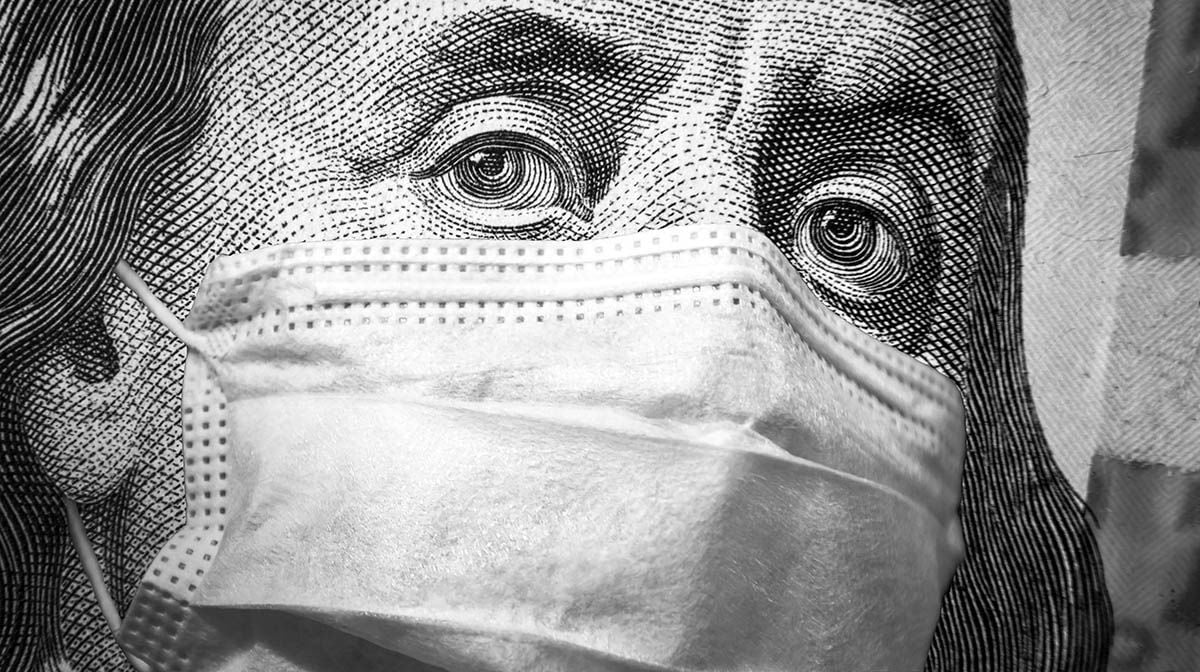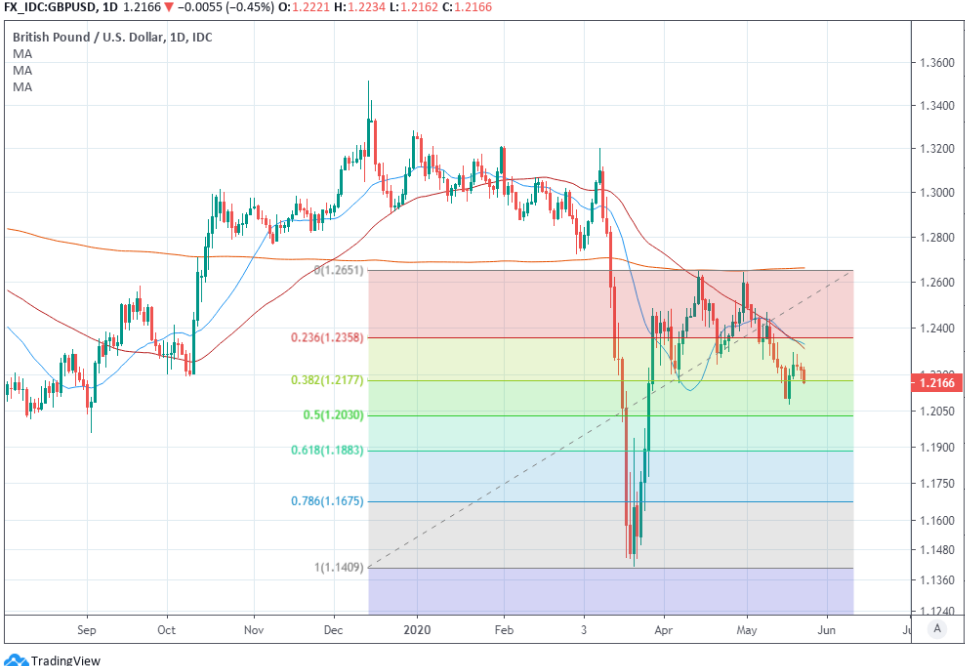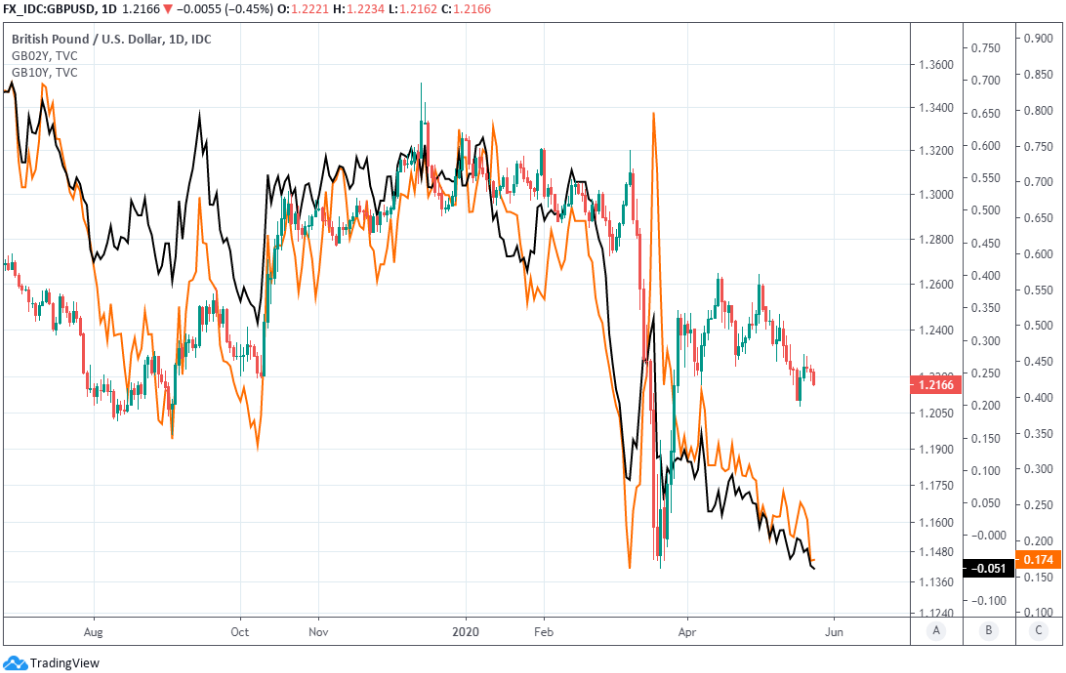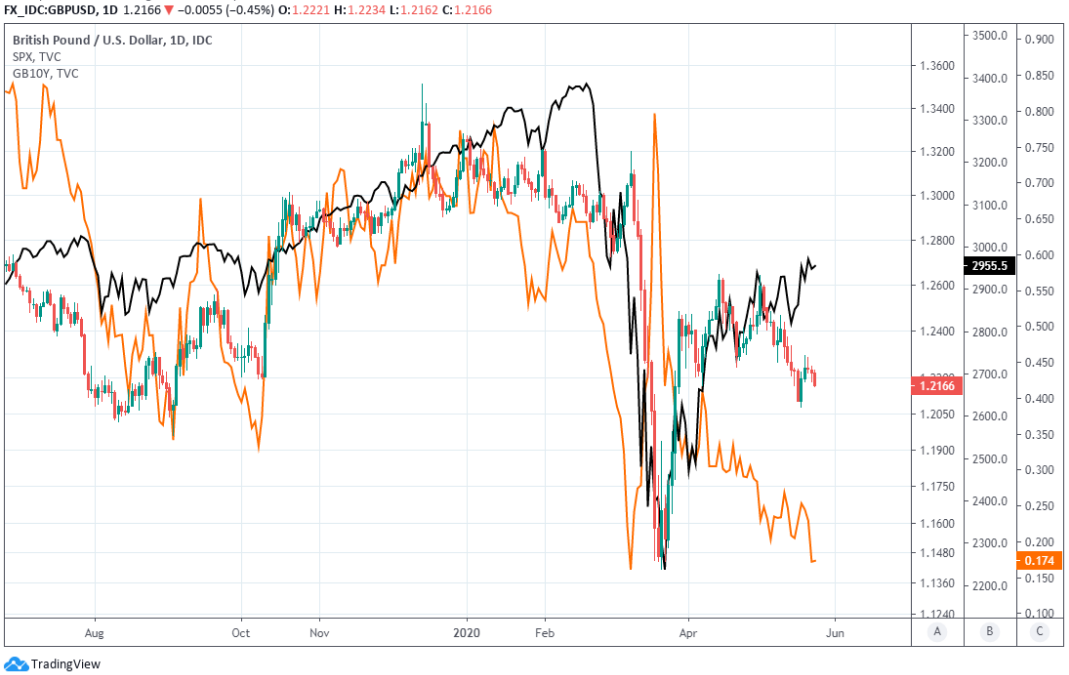Pound-to-Dollar Week Ahead: Vulnerable, with Political Pressure Cooker in Overdrive
- Written by: James Skinner
- GBP/USD headed lower as political pressure cooker enters overdrive.
- Next destination 1.2030 ahead of 1.1883, 1.1675 and March crisis lows.
- Gov adviser controversy irrelevant but school rowback a blow to GBP.
- Botched lockdown exit, Brexit, trade tensions et al thoroughly bearish.

Image © Adobe Images
- GBP/USD spot at time of writing: 1.2168
- Bank transfer rates (indicative): 1.1842-1.1927
- FX specialist rates (indicative): 1.1985-1.2058 >> More information
The Pound bounced tepidly last week but signals from the charts remain bearish while the political pressure cooker that otherwise stains the outlook has gone into overdrive and could prompt another move lower in the coming days.
Sterling advanced just more than half a percent against the Dollar last week aided by an improved mood and appetite for risk among investors, although the British currency still underperformed most comparable rivals.
The Pound's 0.59% gain over a flagging Dollar was the third worst performance of the majors last week, behind only the safe-haven Japanese Yen and Swiss Franc, in a trigger happy market where major stock indices were largely immune to the build-up of tensions between the U.S. and China.
But those market conditions could change and the Pound is no safe-haven. It was near the bottom of the performance table because the Bank of England (BoE) is increasingly extolling the perceived merits of a currency-crushing negative interest rate policy, among other factors. Meanwhile, the charts indicate plenty of downside for a Pound-to-Dollar rate that's still tipped by Commerzbank for steep declines in the months ahead.
"GBP/USD remains directly offered below the 55 day ma at 1.2332 and attention is on the 50% retracement of the March-to-April advance at 1.2030," says Karen Jones, head of technical analysis for currencies, commodities and bonds at Commerzbank. "Further down sit the September low at 1.1958 and the March 20 high at 1.1935. A drop below there is needed to refocus attention on 1.1491, the 2016 low, and also on the March low at 1.1409."
Above: Pound-to-Dollar rate at daily intervals, testing 38.2% Fibonacci retracement of March-to-May rebound.
Jones said in a Friday morning research note that "Fibonacci support en route is found at 1.1883 and at 1.1675." She and her technical colleague Axel Rudolph sold the Pound near 1.24 and are targeting 1.1850 in the short-term, although they also forecast that Sterling will revisit 1.0463 in the coming months. That would be its lowest level since 1985 and one which implies a double-digit percentage fall from Sunday's open.
Economic and political headwinds have driven a sharp move lower in the Pound-to-Dollar rate over the course of May and although the trend has recently wained, the bad news is still flooding in thick and fast. With a bearish technical outlook aside, Sterling enters the new week with the UK government mired in controversy and investors likely fearing another clash between the U.S. and China fresh protests in Hong-Kong at the weekend that resulted in clashes between demonstrators and authorities.
That's a recipe for a risk-averse mood in the currency market that would almost always favour a lower Pound-to-Dollar rate.
Protests were reignited in Hong-Kong at the weekend by a Chinese effort to provide mainland 'security' apparatus with a greater role in the city and financial hub in a further demonstration of blatant disregard for the one-country-two-systems settlement that can only strain U.S.-China relations even further. If not China's relations with the rest of the world, a slice of which is seeking an inquiry into the origins and international handling of the coronavirus.
"Investors are left to guess how hard President Trump is prepared to press China in a fragile election year – with the current focus on potential US sanctions in response to new national security laws in Hong Kong. This story may dominate the early part of the week - especially in the final few days of China’s National People’s Congress," says Francesco Pesole, a strategist at ING. "The likely non-extension of the transition period and the associated negative news flow should weigh on GBP and send GBP/USD even closer to the 1.20 level by June. The upcoming weeks should be therefore associated with downside risks to GBP, hence our modestly bearish view."
Above: Pound-to-Dollar rate with 10-year GB bond yield (orange) and 02-year yield (black).
European investors will return to their desks Monday, which is a public holiday in the UK and U.S., to be greeted by much fanfare over whether one of the government's unelected advisers did or didn't flout the 'lockdown' rules. It's not the first controversy involving the government's unelected advisers although one does this time embroil somebody who's one of Downing Street's strategic masterminds on Brexit and in other areas.
The provervial scalping of a government adviser does not change the electoral dynamics that ultimately govern the Prime Minister's approach toward Brexit so more important for Sterling is the latest in Britain's slowcoach exit from 'lockdown.' The government has encouraged a steady normalisation but while road traffic and usage of public parks is picking up, the public sector is in revolt and large parts of the private sector remain on furlough.
"The broader USD trend is turning neutral in G10. USD is still trending higher vs. GBP," says Vadim Iarolov, a quantitative strategist at BofA Global Research. "Our quant models are overall bearish GBP on the crosses. While USD trends have started to moderate and slow down, GBP is sliding lower against all pairs in G10. GBP/NZD, GBP/SEK and GBP/NOK downtrends are robust, according to bearish Up/Down vol and Residual Skew for puts."
Last week saw the government water down its plan to have schools begin a staged reopening from June 01 after 13 opposition-party-dominated local councils refused to reopen theirs from next month. The UK was no more than a fortnight behind other European countries going into 'lockdown' but with children getting back to school elsewhere, as those other economies reopen, the UK finds itself in a situation where many could remain closed until September.
The government needs schools open to get the economy moving again but its plan did not quell widespread concerns over safety, which are being exploited by a segment of the public sector that has long been partial to political activism. An extended school shutdown, or a super partial reopening, would condemn the economy to operating substantially below capacity while others in Europe reopen, which would see Sterling stick out like a sore thumb to investors.
Above: Pound-to-Dollar rate with 10-year GB yield (orange) and S&P 500 stock index.
"The pound is the clear under-performer in the G10 space – on a month-to-date basis is 2.6% lower versus USD, the worst performing G10 currency by a long way," says Derek Halpenny, head of research, global markets EMEA and international securities at MUFG. "We see the prospect of negative UK rates significant and worth honing in on."
The UK's 'lockdown' exit is stalling just as the Bank of England extolls the perceived merits of a negative interest rate policy, and as another bout of 'no deal Brexit' fears bake in the political pressure cooker. Two of the BoE's senior policymakers, its chief economist and even the Governor himself made appearances last week in which they all came across as keen to emphasise that sub-zero interest rates are indeed considered a part of the Bank's toolbox and that they've not been ruled out for the months ahead.
Financial market pricing was implying at the beginning of last week, a negative BoE base rate from mid-2021 but by the end of the week the implied rate had gone sub-zero by November 2020. This has weighed on the Pound-to-Dollar rate already and could continue to do so as the BoE's June 18 interest rate decision draws closer. That decision coincides with the June 18-to19 European Council meeting that could yet see Prime Minister Boris Johnson walk away from the negotiating table, for a period at least.
"We are conscious that short GBP is already a popular trade and this is the risk in this trade – that we are entering a crowded position. However, as highlighted above, negative rates in the UK would be a very different prospect for GBP when compared to negative rates for EUR, JPY, CHF and SEK. A far greater negative hit for GBP is likely," says Halpenny, who's a seller of GBP/JPY.
Meanwhile, over in the U.S., investors will be keen to see the second estimate of GDP growth for the first quarter as well as further clarity on President Donald Trump's likely response to China's encroachment on what are effectively Hong Kong affairs under the one-country-two-systems model. GDP was -4.8% annualised at the initial reading and consensus favours that outcome at 13:30 Thursday, although investors might care more about any downside surprise.
China is legislating for its security services to have a direct role in the city at a time when trade tensions are rising between the world's two largest economies again, placing January's 'phase one deal' and the global economic recovery out of the coronavirus trough in doubt. This might not bode well for risk appetite or the stock markets the Pound-to-Dollar rate had a positive correlation with until recently.







